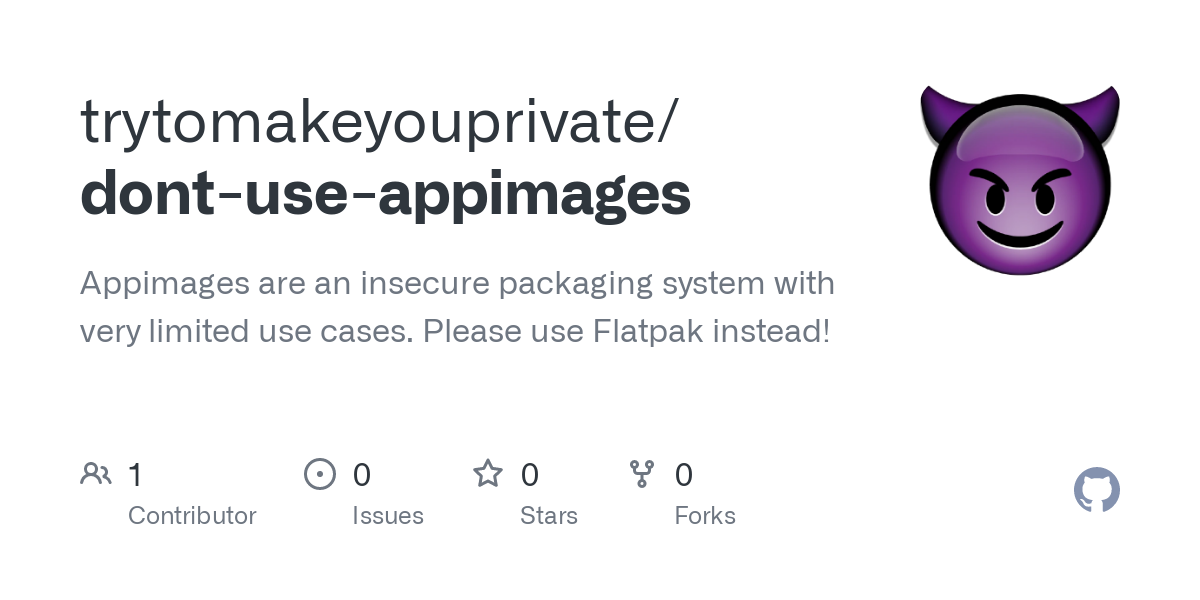Appimages totally suck, because many developers think they were a real packaging format and support them exclusively.
Their use case is tiny, and in 99% of cases Flatpak is just better.
I could not find a single post or article about all the problems they have, so I wrote this.
This is not about shaming open source contributors. But Appimages are obviously broken, pretty badly maintained, while organizations/companies like Balena, Nextcloud etc. don’t seem to get that.



Dont know where user installed tar archives (with statically linked binaries or including deps) would have dep conflicts, maybe if they are not statically linked.
The self updating stuff and desktop icons is personal opinion and not the common way on Desktop Linux, so I skip that.
That is called a package manager, with a repo, with gpg signing etc. On Android (which I mentioned) updates are secure. Let alone the point that appimages are not updated in a regular way, they are just replaced.
No the difference is huge. If you are used to downloading software from websites, a faked website can easily lead to downloaded malware. Flathub can be added with a click and flatpak is included in distros, which means no hunting on the internet and no accidental clicks.
And as I said, until nobody downloads
.flatpakpackages online, and there may be an occasion where this is normal behavior, people will believe malware links are legit.Appimages are distributed everywhere, just as .exe files for Windows. This means they are favored by developers used to Windows and Mac, and those will not add them to a repo instead.
So a faked website of whatever etcher or something is easy.
The fact that Linux malware is not a thing, while Appimages clearly give the headstart for that, is a miracle.
Flatpaks are not secure because their sandboxes are weakened to not have such issues. This is due to apps not following secure standards, and until that is fixed they are insecure or broken or both. (Apps need to write configs in the container, they should use portals etc.)
I maintain a list of flatpak apps following modern standards, which is a small portion but getting better.
Linux is only somewhat secure because everything is FOSS and comes from repos.
This is broken by appimages, that can easily distribute malware and thus fix the “my malware is not running on that distro” issue.
Every software that can write to your .bashrc can easily catch your sudo password.
Yes linux experts would put them there. As mentioned in that text malware would also install itself there, so on secure systems this should be only writable by root/ some elevated group privilege.
But apart from that users put them on the desktop, or in some random folder, I mean that dir is hidden for a reason.
Or put it in that PATH and then link to the desktop, resulting in a broken link when you remove the app.
If something is not scaleable its not a good concept. The fact that you will only install a couple of appimage apps is enough proof.
On modern atomic distros users can rely purely on flatpak.
Btw see the linked dedup checker. You may download more dependencies but they are linked between each other and not actually take up so much space.
We need to overthink those habits. You dont just “try an app”, you run unsandboxed code from an unverified origin. As mentioned above, this could be totally fine, and also add a function to your bashrc that catches your sudo password (the next time you use it) and sends it to a server.
The secure way to do that is completely unpractical.
This is unusable. And repositories do this automatically without anything you need to do. For sure you could “extra check the website” and say "
Also app data will be everywhere, often in its traditional location, while there is no package manager at all to delete them. Flatpaks store all their stuff (when devs care and not just ignore that, cough Cryptomator) in their container and data can be easily removed during uninstallation, GUI stores show a popup to delete data and I also made a small script to do that.
And that “try it out” app will either have no desktop entry or that entry needs to be manually and will be still there after uninstalling.
This may be a reason, but this is only for testing then. But for sure, when its a small project, getting it on Flathub may be much efford.
I can imagine the developer experience is easiser. Flatpaks are simply very “defined” and need all that metadata and more to be complete. But needing to use available runtimes is a good thing mostly, its basically supporting a specific distro.
Flatpak through CLI is fine (I would like to have a standalone small store just for flatpak), Discover is nice too. The Linux Mint store also seemed fine but not much experience. (Linux Mint has some Wayland support now, so there is a secureblue Cinnamon spin, have to try that). The Cosmic store is just a stub currently, lets see!
Cheers!